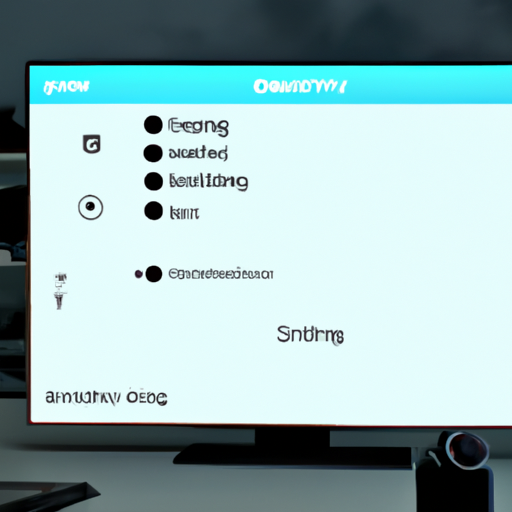How to Adjust Picture Settings on Your Samsung TV for Optimal Viewing
Are you looking to get the most out of your Samsung TV? Adjusting the picture settings can help you get the best viewing experience possible. Here’s how to do it:
1. Start by accessing the Picture Settings menu. You can do this by pressing the Menu button on your remote and selecting Picture.
2. Once you’re in the Picture Settings menu, you’ll see a variety of options. The first one is Picture Mode. This is where you can choose from different preset picture settings, such as Standard, Dynamic, Natural, Movie, or Custom. Select the one that best suits your viewing preferences.
3. Next, you can adjust the Backlight setting. This will determine how bright or dark the picture is. You can adjust this setting to your liking.
4. You can also adjust the Color Tone setting. This will determine the color temperature of the picture. You can choose from Warm, Standard, or Cool.
5. Finally, you can adjust the Sharpness setting. This will determine how sharp or blurry the picture is. You can adjust this setting to your liking.
Once you’ve adjusted all of the settings to your liking, you’re ready to enjoy your Samsung TV with the best picture quality possible. Enjoy!
Exploring the Different Audio Settings on Your Samsung TV
Welcome to the wonderful world of audio settings on your Samsung TV! Whether you’re a movie buff, a music lover, or just someone who enjoys a good show, you’ll be glad to know that your Samsung TV has a variety of audio settings to help you get the most out of your viewing experience.
Let’s start with the basics. Your Samsung TV has a built-in equalizer that allows you to adjust the sound levels of different frequencies. This is great for fine-tuning the sound of your TV to your personal preferences. You can also adjust the balance between the left and right speakers, as well as the overall volume.
Next, you can choose from a variety of sound modes. These include Standard, Music, Movie, and Sports. Each mode is designed to optimize the sound for the type of content you’re watching. For example, the Movie mode will enhance the sound of action scenes, while the Music mode will make your favorite tunes sound even better.
Finally, you can also adjust the audio output of your Samsung TV. You can choose between Digital (optical) and Analog (headphone jack) outputs. Digital is the best option for connecting to a home theater system, while Analog is great for connecting to headphones or portable speakers.
We hope this guide has helped you understand the different audio settings on your Samsung TV. With these settings, you can customize the sound of your TV to your exact preferences. Enjoy!
Understanding the Different Signal Options for Your Samsung TV

Welcome to the world of Samsung TVs! With so many different signal options available, it can be hard to know which one is right for you. In this article, we’ll break down the different signal options available for your Samsung TV, so you can make an informed decision.
First, let’s talk about the most common signal option: HDMI. HDMI stands for High-Definition Multimedia Interface, and it’s the most popular way to connect your TV to other devices. HDMI cables are used to connect your TV to a Blu-ray player, gaming console, or streaming device. It’s the best way to get the highest quality picture and sound.
Next, there’s component video. Component video is an analog signal that’s used to connect your TV to older devices, such as VCRs or DVD players. It’s not as high-quality as HDMI, but it’s still a good option if you’re connecting to an older device.
Finally, there’s composite video. Composite video is an analog signal that’s used to connect your TV to even older devices, such as VCRs or camcorders. It’s the lowest quality signal option, but it’s still a viable option if you’re connecting to an older device.
We hope this article has helped you understand the different signal options available for your Samsung TV. With the right signal option, you can get the best picture and sound quality from your TV.
Tips for Optimizing Your Samsung TV Settings for the Best Performance
1. Adjust the Picture Mode: Depending on the type of content you’re watching, you can adjust the picture mode to get the best performance. For movies, choose the “Movie” mode, for sports, choose the “Sports” mode, and for general viewing, choose the “Standard” mode.
2. Adjust the Backlight: The backlight setting controls the brightness of the picture. If the backlight is too high, the picture will be too bright and washed out. If the backlight is too low, the picture will be too dark. Adjust the backlight to a level that is comfortable for your eyes.
3. Turn on Auto Motion Plus: Auto Motion Plus is a feature that helps reduce motion blur and judder. It can be found in the Picture Settings menu.
4. Turn off Dynamic Contrast: Dynamic Contrast is a feature that adjusts the contrast of the picture depending on the content. This can cause the picture to look unnatural and can also cause banding. It’s best to turn this feature off.
5. Turn off Digital Clean View: Digital Clean View is a feature that helps reduce noise in the picture. However, it can also cause the picture to look soft and blurry. It’s best to turn this feature off.
6. Adjust the Color Tone: The Color Tone setting controls the color temperature of the picture. If the color tone is too warm, the picture will look too yellow. If the color tone is too cool, the picture will look too blue. Adjust the color tone to a level that looks natural to you.
7. Adjust the Sharpness: The Sharpness setting controls the sharpness of the picture. If the sharpness is too high, the picture will look too sharp and artificial. If the sharpness is too low, the picture will look soft and blurry. Adjust the sharpness to a level that looks natural to you.
By following these tips, you can optimize your Samsung TV settings for the best performance. Enjoy your viewing experience!
Troubleshooting Common Issues with Your Samsung TV Settings and Signal Options
Having trouble with your Samsung TV settings or signal options? Don’t worry, you’re not alone! Here are some common issues and solutions to help you get back to enjoying your TV.
1. Picture Settings: If you’re having trouble with the picture settings on your Samsung TV, try resetting them to the factory defaults. To do this, go to the Picture Settings menu and select Reset Picture Settings. This will reset all of your picture settings to the factory defaults.
2. Audio Settings: If you’re having trouble with the audio settings on your Samsung TV, try resetting them to the factory defaults. To do this, go to the Audio Settings menu and select Reset Audio Settings. This will reset all of your audio settings to the factory defaults.
3. Signal Options: If you’re having trouble with the signal options on your Samsung TV, try resetting them to the factory defaults. To do this, go to the Signal Options menu and select Reset Signal Options. This will reset all of your signal options to the factory defaults.
4. HDMI Settings: If you’re having trouble with the HDMI settings on your Samsung TV, try resetting them to the factory defaults. To do this, go to the HDMI Settings menu and select Reset HDMI Settings. This will reset all of your HDMI settings to the factory defaults.
We hope these tips help you get your Samsung TV back up and running. If you’re still having trouble, contact your local Samsung service center for additional assistance.
